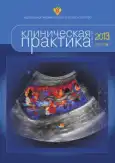SYSTOLIC FUNCTION AND DYSSYNCHRONY IN PATIENTS WITH ACUTE MYOCARDIAL INFARCTION
- Authors: Yaroschuk NA1, Kochmasheva VV2, Dityatev VP3, Kerbikov OB4
-
Affiliations:
- ГБУЗ СО "Городская больница №3", г. Каменск-Уральский, Свердловская область
- ГБУЗ СО "Свердловская областная клиническая больница №1", г. Екатеринбург
- Уральская государственная медицинская академия, г. Екатеринбург
- ФГБУ ФНКЦ ФМБА России
- Issue: Vol 4, No 2 (2013)
- Pages: 4-11
- Section: Articles
- URL: https://journals.rcsi.science/clinpractice/article/view/8252
- DOI: https://doi.org/10.17816/clinpract424-11
- ID: 8252
Cite item
Full Text
Abstract
Full Text
##article.viewOnOriginalSite##About the authors
N A Yaroschuk
ГБУЗ СО "Городская больница №3", г. Каменск-Уральский, Свердловская область
Email: natalijayaroshchuk@mail.ru
заведующая отделением функциональной диагностики ГБУЗ СО "Городская больница №3", г. Каменск-Уральский
V V Kochmasheva
ГБУЗ СО "Свердловская областная клиническая больница №1", г. Екатеринбургзаведующая отделением функциональной и ультразвуковой диагностики
V P Dityatev
Уральская государственная медицинская академия, г. Екатеринбургпрофессор кафедры терапии с курсом кардиологии ФПК и ПП ГОУ ВПО "Уральская государственная медицинская академия", д.м.н.
O B Kerbikov
ФГБУ ФНКЦ ФМБА России
Email: o.kerbikov@gmail.com
старший научный сотрудник ФГБУ "Федеральный научно-клинический центр специализированных видов медицинской помощи и медицинских технологий ФМБА России", к.м.н. Москва, Ореховый бульвар,28
References
- Алехин М.Н., Сидоренко Б.А. Современные подходы к эхокардиографической оценке систолической функции сердца. Кардиология. 2007;7: 4 12.
- Беленков Ю.Н. Терновой С.К. Функциональная диагностика сердечно-сосудистых заболеваний. М.: ГЭОТАР-Медиа; 2007; с. 355-412.
- Corsi C., Lang R.M.,Veronesi F. [et al.] Volumetric quantification of global and regional left ventricular function from real-time three-dimensional echocardiographic images. Circulation. 2005;112:1161-70.
- Sugeng L., Mor-Avi V., Lang R.M. Three-dimensional echocardiography: coming оf age. Heart. 2008 Sep; 94(9):1123-5.
- Muraru D., Badano L.P., Piccoli G. Validation of a novel automated border-detection algorithm for rapid and accurate quantitation of left ventricular volumes based on three-dimensional echocardiography. Eur J Echocardiogr. 2010 May;11(4):359-68.
- Кapetanakis S., Kearney M.Т., Siva А. [et al.] Real-Time three-dimensional echocardiography: a novel technique to quantify global left ventricular mechanical dyssynchrony. Circulation. 2005 Aug 16; 112(7): 992-1000.
- Hare J.L., Jenkins C., Nakatani S. [et al.] Feasibility and clinical decision-making with 3D echocardiography in routine practice. Heart. 2008 Apr; 94(4):440-5.
- Lang RM, Mor-Avi V, Dent JM, Kramer CM. Three-dimensional echocardiography: is it ready for Everyday Clinical Use? JACC Cardiovasc Imaging. 2009 Jan;2(1):114-7.
- Soliman O.I.I., Van Dalen B.M., Geleijnse ML. Semi-automated left ventricular function assessment by real-time three-dimensional echocardiography is ready for prime time. Eur Heart J. 2009; 30(18): (Suppl 1) р.342.
- /ASERECOMMEND
- Jenkins C., Chan J, Hanekom L, Marwick TH. Accuracy and feasibility of online 3-dimensional echocardiography for measurement of left ventricular parameters. J Am Soc Echocardiogr. 2006; 19(9): 1119-28.
- Jaochim Nesser H, Sugeng L, Corsi C. [et al.] Volumetric analysis of regional left ventricular function with real-time three-dimensional echocardiography: validation by magnetic resonance and clinical utility testing. Heart. May;93(5):572-8.
- Leung KY, Bosch JG. Automated border detection in three-dimensional echocardiography: principles and promises. Eur J Echocardiogr. 2010 Mar; 11(2): 97-108.
- Iskandrian A.E., Hage F.G. Imaging Acute MI in the 21st Century. JACC Cardiovasc Imaging. 2013 Mar; 6(3): 370-2.
- Аlonso L. Hari P., Pidlaoan V. Acute myocarditis: can novel echocardiographic techniques assist with diagnosis? Eur J Echocardiogr. 2010 Apr;11(3):E5.
- Zhang Q,, Yu C,M. Clinical Implication of Mechanical Dyssynchrony in Heart Failure. J Cardiovasc Ultrasound. 2012 Sep;20(3):117-23.
- De Castro S, Faletra F, Di Angelantonio E. [et al.]. Tomographic left ventricular volumetric emptying analysis by real-time 3-dimensional echocardiography: influence of left ventricular dysfunction with and without electrical dyssynchrony. Circ Cardiovasc Imaging. 2008 Jul;1(1):41-9.
- Smiseth OA, Russell K, Skulstad H. The role of echocardiography in quantification of left ventricular dyssynchrony: state of the art and future directions. Eur Heart J Cardiovasc Imaging. 2012 Jan;13(1):61-8.
- Lamia B. Tanabe М., et al. Quantifying the role of regional dyssynchrony on global left ventricular performance. JACC Cardiovasc Imaging; 2009; 2(12): 1350-6.
- Mollema S.A., Liem S.S. Left ventricular dyssynchrony acutely after myocardial infarction predicts left ventricular remodeling. Am J Coll Cardiol. 2007, Oct 16; 50(16):1532-72.
- Weir R.A., McMurray J.J. Epidemiology of heart failure and left ventricular systolic dysfunction after acute myocardial infarction: prevalence, clinical characteristics and prognostic importance. Am J Cardiol; 2006, May 22;97(10A):13-25.
- Бойцов С.А. Никулина Н.Н. Внезапная сердечная смерть у больных ишемической болезнью сердца. (По результатам Российского многоцентрового качества диагностики и лечения острых форм ИБС (РЕЗОНАНС) /Бойцов С.А., // Российский кардиологический журнал. 2011, 2 (88) стр. 59-64.
- Costal F. Ferreiral J. Impact of ESC/ACCF/ AHA/ WHF universal definition of myocardial infarction on mortality at 10 years. Eur Heart J; 2012, Vol. 33(20): 2544-50.
- Marijon E. Puymirat E. [et al.], Ventricular fibrillation is a major determinant of in-hospital mortality but does not impact long-term mortality after myocardial infarction: the FAST-MI registry. Eur Heart J. 2011 Aug; Vol. 32 (Suppl 1): 869.
- deKam P.J., Nicolosi G.L. [et al.] Prediction of 6 months left ventricular dilatation after myocardial infarction in relation to cardiac morbidity and mortality. Application of a new dilatation model to GISSI-3 data. Eur Heart J. 2002,Vol.23(7):536-42.
- Gajarsa J.J., Kloner R.A. Left ventricular remodeling in the post-infarction heart: a review of cellular, molecular mechanisms, and therapeutic modalities. Heart Fail Rev. 2011 Jan;16(1): 13-21.
- French B.A., Kramer C.M. Mechanisms of PostInfarct Left Ventricular Remodeling. Drug Discov Today Dis Mech. 2007;4(3):185-196.
- Yousef Z.R., Redwood S.R., MarberM.S. Postinfarction left ventricular remodeling: a pathophysiological and therapeutic review. Cardiovasc Drugs Ther. 2000; Vol.14(3): 243-52.
Supplementary files






